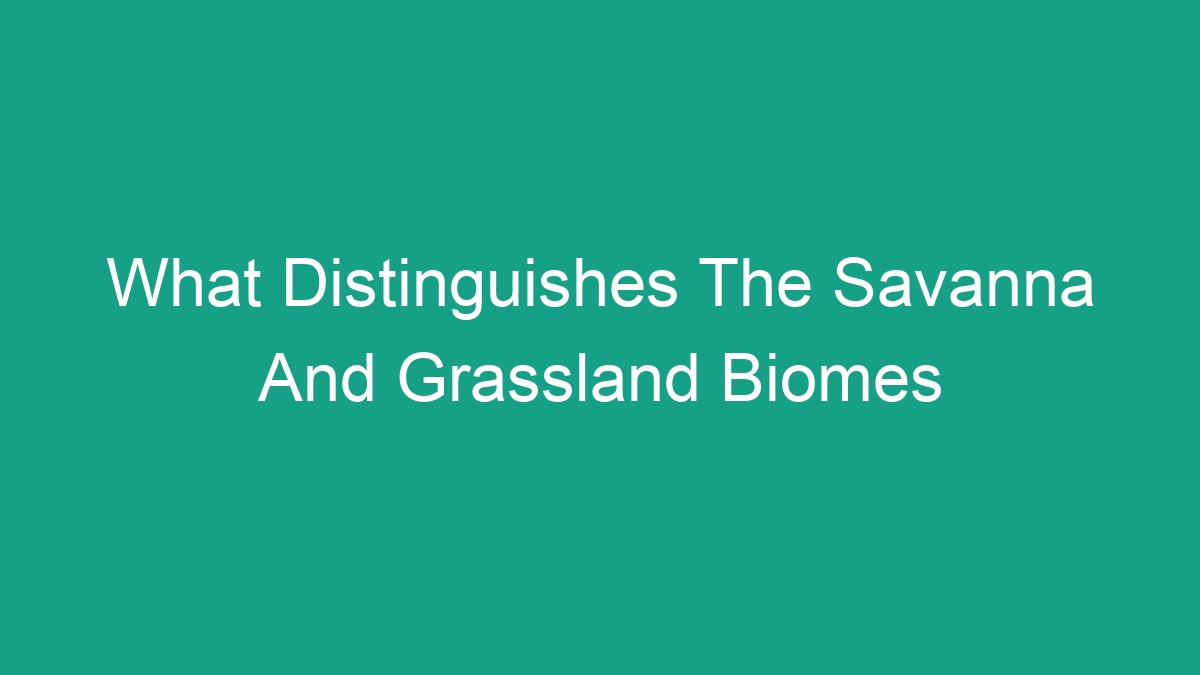
The world is home to a variety of biomes, each with its own unique features and characteristics. Two of the most fascinating biomes are the savanna and grassland biomes. While they may seem similar at first glance, there are distinct differences that set them apart. In this article, we will delve into what distinguishes the savanna and grassland biomes, including their climate, vegetation, and wildlife.
1. Climate
The climate is one of the primary factors that differentiate the savanna and grassland biomes.
- Savanna Biome: The savanna biome is characterized by a tropical climate with distinct wet and dry seasons. The wet season brings heavy rainfall, while the dry season is marked by drought. The average annual rainfall in the savanna biome ranges from 20-50 inches.
- Grassland Biome: Grasslands, on the other hand, have a more temperate climate with regular precipitation throughout the year. The average annual rainfall in grasslands ranges from 10-30 inches, making them drier than savannas.
2. Vegetation
Another key difference between the savanna and grassland biomes lies in their vegetation.
- Savanna Biome: The dominant vegetation in the savanna biome consists of grasses and scattered trees, such as acacias and baobabs. The grasses are well-adapted to the seasonal drought, while the trees have deep roots to access water during dry periods.
- Grassland Biome: Grasslands are predominantly covered by grasses, with few trees or shrubs. The grasses in this biome are often tall and dense, providing habitat and food for a diverse range of herbivores.
3. Wildlife
The wildlife in the savanna and grassland biomes is also distinct, with each biome supporting a unique array of species.
- Savanna Biome: The savanna is home to iconic African wildlife, including elephants, giraffes, lions, zebras, and wildebeests. These species have adapted to the seasonal patterns of the savanna, migrating in search of food and water.
- Grassland Biome: Grasslands are teeming with herbivores, such as bison, antelope, and prairie dogs, which in turn support a diverse predator population, including wolves, coyotes, and birds of prey.
4. Human Impact
Human activities have had a significant impact on both the savanna and grassland biomes.
- Savanna Biome: The expansion of agriculture and urban development has led to significant habitat loss and fragmentation in the savanna biome. This has resulted in the decline of many wildlife species, as well as increased competition for resources.
- Grassland Biome: Grasslands have also been heavily affected by human activities, particularly through the conversion of grasslands into agricultural land. This has led to the loss of native grass species and the fragmentation of habitats for wildlife.
5. Conservation Efforts
Conservation efforts are crucial for protecting the biodiversity of the savanna and grassland biomes.
- Savanna Biome: Conservation organizations are working to establish protected areas and wildlife corridors to safeguard the savanna biome and its iconic wildlife. Reforestation and sustainable land management practices are also being implemented to restore degraded areas.
- Grassland Biome: Similar efforts are underway to conserve grassland ecosystems, including the establishment of grassland reserves and restoration projects to re-establish native plant species and habitats for wildlife.
FAQ
Q: Can savannas and grasslands exist in the same region?
A: Yes, savannas and grasslands can coexist in the same region, as their boundaries are not always clearly defined. The transition between these biomes can be gradual, with variations in climate, vegetation, and wildlife.
Q: What are the main threats to savanna and grassland biomes?
A: The main threats to savanna and grassland biomes include habitat loss, overgrazing, climate change, and invasive species. These factors can disrupt the delicate balance of these ecosystems and lead to the decline of native species.
Q: How can individuals help conserve savanna and grassland biomes?
A: Individuals can contribute to the conservation of savanna and grassland biomes by supporting sustainable land management practices, reducing their carbon footprint, and advocating for the protection of these ecosystems. Supporting conservation organizations and participating in reforestation efforts are also impactful ways to make a difference.
In conclusion, the savanna and grassland biomes are distinguished by their climate, vegetation, wildlife, and human impact. Understanding these differences is essential for the conservation and sustainable management of these vital ecosystems.




